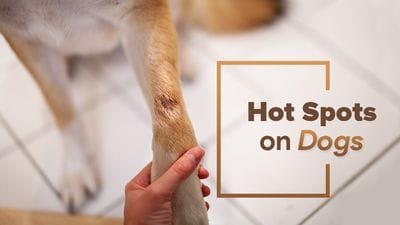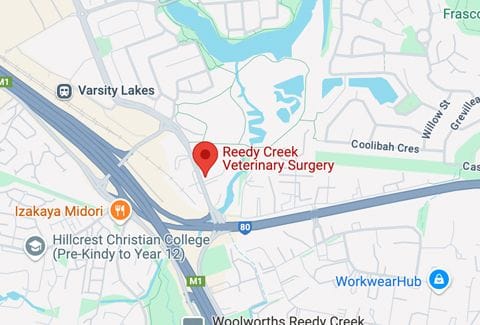Hot Spots on Dogs
HOT SPOTS ON DOGS

Hot spots are one of the most common skin conditions in dogs. More common in hotter months, hot spots can be a problem for Australian dogs due to the heat and humidity here.
What are hot spots on dogs?
Acute moist dermatitis, or hot spots, are localised areas of skin inflammation and bacterial infection. They may start as small red spots (resembling insect bites), but can quickly worsen and develop into a painful lesion.
What causes hot spots on dogs?
Hot spots can sometimes be self-inflicted, and also be worsened by a dog’s own agitation and behaviours. Scratching, licking, and chewing at infected areas quickly result in further trauma and bacterial infections.
The initial agitation is often caused by something that is uncomfortable for pets, like:
Parasites (ticks, fleas, lice)
Food or environmental allergies
Ear or skin infections
Dermatitis
Trapped moisture from swimming or bathing
Trapped debris like dirt or sand
Dirty coats or matting
Stress, boredom, or anxiety resulting in excessive licking
Many of these conditions are recurring, meaning if they aren’t resolved, hot spots will continually return. Additionally, some breeds are more prone to hot spots, such as those with long or thick coats (like Labrador Retrievers, Rottweilers, St Bernards, and German Shepherds).
Hot spot symptoms on dogs
Skin conditions for dogs share many clinical signs, which is why it’s important to ensure an accurate diagnosis early on for fast treatment. Common signs a dog is affected by hot spots can include:
Areas of redness
Swelling
Hair loss
Fur surrounding the area will often be damp, matted, or crusting.
Treatment and Prevention of hot spots on dogs
If your pet is showing any symptoms mentioned above or is experiencing new or unusual behaviours, please contact us. For issues like hot spots, delaying treatment can exacerbate problems.
In order to effectively treat hot spots on dogs, a veterinarian will first need to accurately diagnose the initial cause of the agitation. This will include a full consultation with your veterinarian, examining the physical condition of your dog, and learning more about their diet and day-to-day life.
Once a diagnosis has been made, treatment may be prescribed. Methods to prevent your pet from licking the area may also be provided.
Some of the most effective ways to prevent pets from further agitating their hot spots include:
Elizabethan collars or cones
Cleaning the area daily with veterinary-approved antiseptics
Prescribed medications
Distractions like puzzle toys or long-lasting treats
With veterinary care, hot spots can often be treated within one to two weeks.
Prevention of hot spots in dogs
Once hot spots have been treated, owners can help prevent them from re-occurring with advice from their vet. Some things that may help include:
If a pet is licking due to stress or boredom, owners may be recommended to exercise the pet more often or stimulate their minds with a change of location.
If a pet’s hot spots have been caused by allergies or irritation, a change of diet or medication may be prescribed.
If a pet’s coat is likely the cause of agitation, a change in shampoo or bathing frequency may be advised.
What to do if you suspect your pet has hot spots
If your pet is showing signs of hot spots, or seems uncomfortable and agitated, please contact us. An accurate diagnosis and treatment will leave them feeling happier, less agitated, and more comfortable.
Reedy Creek Vet is open Monday to Friday from 8 am to 5:30 pm, and Saturdays from 8 am till midday. Our team offers veterinary consultations for both new and existing patients - if you would like to book a consultation, please call us on 07 5593 8395 and speak to our friendly reception team on (07) 5593 8395. Alternatively, appointments can be booked online on our website.
| Tags:DogClient InformationHealth AdviceProactive Pet Care |
&geometry(140x140))

